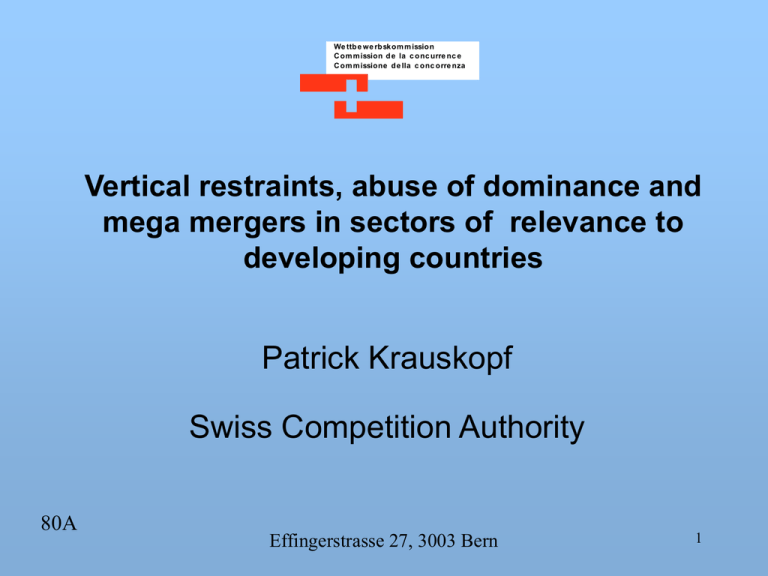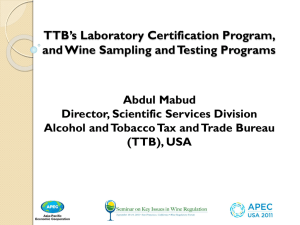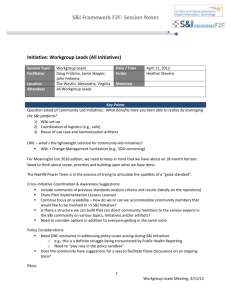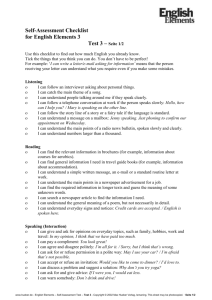Document 10389781
advertisement

We ttb e we rb skom m issio n C om m ission d e la c o nc urre nc e C om m issione d e lla c onc orre nza Vertical restraints, abuse of dominance and mega mergers in sectors of relevance to developing countries Patrick Krauskopf Swiss Competition Authority 80A Effingerstrasse 27, 3003 Bern 1 We ttb e we rb skom m issio n C om m ission d e la c o nc urre nc e C om m issione d e lla c onc orre nza Vertical restrictions Definition The three main kinds of restrictions Why are restrictions used instead of vertical integration Economic analysis Desirable or undesirable effects of vertical restrictions Consumer: price discrimination Doctrines/Theories and legal framework, some examples USA Europe Switzerland Vertical restrictions in developing countries Seite 2 Vertical restrictions Definition The three main kinds of restrictions 1. 2. 3. Resale price maintenance Exclusive dealing Exclusive territory or territorial market restrictions 1. 2. 3. We ttb e we rb skom m issio n C om m ission d e la c o nc urre nc e C om m issione d e lla c onc orre nza Why are restrictions used instead of vertical integration? Vertical restrictions can be useful in solving problems of distribution: Double monopoly markup Some distributors may free ride (on other distributors) Some manufacturers may free ride (on other manufacturers) Each of these problems may be resolved with vertical restrictions Seite 3 We ttb e we rb skom m issio n C om m ission d e la c o nc urre nc e C om m issione d e lla c onc orre nza Desirable or Undesirable effects of vertical restrictions 1. Vertical restraints are no longer regarded as per se suspicious or per se pro-competitive 2. Analysis should concentrate on the impact on the market rather than the form of the agreement 3. Vertical restrictions can be used for other anticompetitive purposes Consumer: price discrimination 1. Partitioning effect 2. Parallel trade Seite 4 We ttb e we rb skom m issio n C om m ission d e la c o nc urre nc e C om m issione d e lla c onc orre nza Doctrines/Theories and legal framework USA 1. Section 1 of the Sherman Act 2. GTE Sylvania Europe 1. Article 81 Treaty of Amsterdam 2. block exemption Switzerland Vertical restrictions in developing countries Seite 5 Dominance We ttb e we rb skom m issio n C om m ission d e la c o nc urre nc e C om m issione d e lla c onc orre nza Definition Methodology: Proving cases concerning the abuse of market dominance A. Market definition: two basic dimensions 1. Product 2. Geography B. Market share C. Market structure Types of abuse of dominance Doctrines/Theories and legal framework USA Europe Dominance in developing countries Seite 6 We ttb e we rb skom m issio n C om m ission d e la c o nc urre nc e C om m issione d e lla c onc orre nza Dominance Definition In this concept there are two elements 1. A dominant position 2. Market power In general competition laws or regulations prohibit 1. To obtain dominance by means other than superior ability to serve consumer needs, and/or 2. To abuse of a dominant position Seite 7 We ttb e we rb skom m issio n C om m ission d e la c o nc urre nc e C om m issione d e lla c onc orre nza Methodology: Proving cases concerning the abuse of market dominance Market definition: two basic dimensions 1. Product I. Substitutability a. Demand side b. Supply side II. Barriers to entry a. Sunk cost b. Government erect statutory or regulated barriers c. Strategic behaviour – to discourage entry 2. Geography Market share Market structure Seite 8 We ttb e we rb skom m issio n C om m ission d e la c o nc urre nc e C om m issione d e lla c onc orre nza Types of abuse of dominance 1) Requiring Firms to Deal Exclusively with a Dominant Firm 2) Tying 3) Predation 4) Price discrimination and intellectual property rights 5) Refusal to deal 6) Price levels Seite 9 We ttb e we rb skom m issio n C om m ission d e la c o nc urre nc e C om m issione d e lla c onc orre nza Doctrines/Theories and legal framework Europe Article 82 Treaty of Amsterdam USA Section 2 Sherman Act Interpretation: Chicago School Dominance in developing countries Economic efficiency or promoting small business to let a company expand and strengthen its position on the national market? Seite 10 We ttb e we rb skom m issio n C om m ission d e la c o nc urre nc e C om m issione d e lla c onc orre nza Merger Definition Why institute a merger control? Merger in developing countries: Merger and FDI Seite 11 Merger We ttb e we rb skom m issio n C om m ission d e la c o nc urre nc e C om m issione d e lla c onc orre nza Definition Why institute a merger control? 1. With smaller markets merger control is unnecessary 2. Having a “national champion” even abusing a monopoly position domestically might allow it to be competitive abroad in third markets. Two objections can be made to these views: 1. it is often the case that monopolies enjoy their “monopoly rent” without becoming more competitive abroad, at the expense of domestic consumers and eventually of the development of the economy as a whole. 2. if the local market is open to competition from imports or FDI, the world market might be relevant for the merger-control test, and the single domestic supplier might anyway be authorized to merge. Seite 12 We ttb e we rb skom m issio n C om m ission d e la c o nc urre nc e C om m issione d e lla c onc orre nza Merger in developing countries: Merger and FDI WIR 2000 suggests that: the financial resources provided through M&As do not always add to the capital stock. FDI through M&As is less likely to transfer new or better technologies or skills than Greenfield FDI, at least at the time of entry. FDI through M&As does not generate employment FDI through M&As can increase concentration and lead to anticompetitive results. Two last comments: The most important policy concern is competition policy. The report WIR 2000 concludes: "Competition policy can no longer be pursued effectively through national action alone”. Seite 13








